2003 FORD WINDSTAR air conditioning
[x] Cancel search: air conditioningPage 1 of 240

Introduction 4
Instrument Cluster 10
Warning and control lights 10
Gauges 13
Entertainment Systems 16
AM/FM stereo cassette with CD 16
AM/FM stereo cassette 18
AM/FM stereo with CD 24
Rear seat controls 27
Climate Controls 30
Manual heating and air conditioning 30
Rear window defroster 34
Lights 35
Headlamps 35
Turn signal control 38
Bulb replacement 40
Driver Controls 44
Windshield wiper/washer control 44
Steering wheel adjustment 45
Power windows 50
Mirrors 51
Speed control (Cruise control) 53
Message center 62
Locks and Security 75
Keys 75
Locks 75
Anti-theft system 77
Table of Contents
1
Page 31 of 240
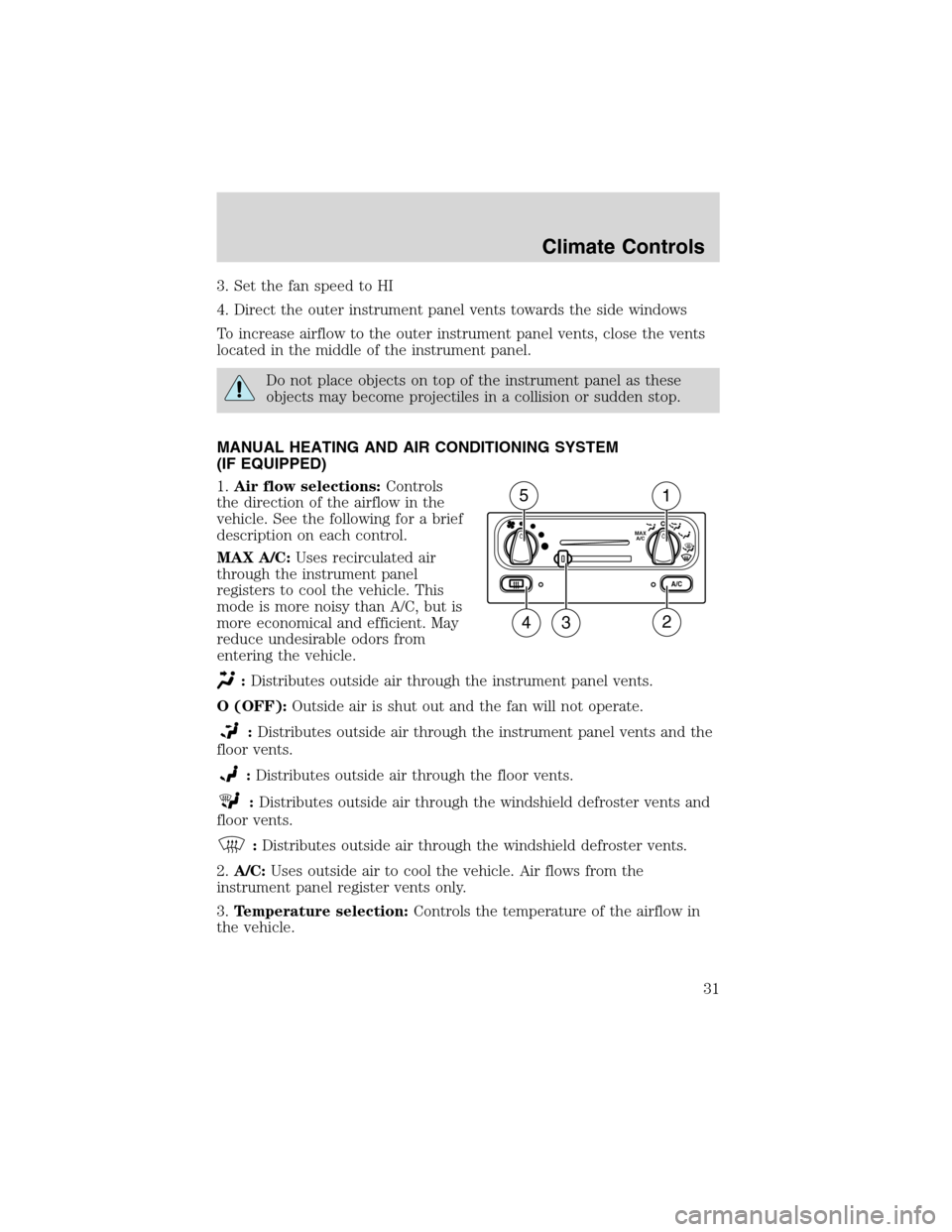
3. Set the fan speed to HI
4. Direct the outer instrument panel vents towards the side windows
To increase airflow to the outer instrument panel vents, close the vents
located in the middle of the instrument panel.
Do not place objects on top of the instrument panel as these
objects may become projectiles in a collision or sudden stop.
MANUAL HEATING AND AIR CONDITIONING SYSTEM
(IF EQUIPPED)
1.Air flow selections:Controls
the direction of the airflow in the
vehicle. See the following for a brief
description on each control.
MAX A/C:Uses recirculated air
through the instrument panel
registers to cool the vehicle. This
mode is more noisy than A/C, but is
more economical and efficient. May
reduce undesirable odors from
entering the vehicle.
:Distributes outside air through the instrument panel vents.
O (OFF):Outside air is shut out and the fan will not operate.
:Distributes outside air through the instrument panel vents and the
floor vents.
:Distributes outside air through the floor vents.
:Distributes outside air through the windshield defroster vents and
floor vents.
:Distributes outside air through the windshield defroster vents.
2.A/C:Uses outside air to cool the vehicle. Air flows from the
instrument panel register vents only.
3.Temperature selection:Controls the temperature of the airflow in
the vehicle.
A/C
MAX
A/C
15
234
Climate Controls
31
Page 33 of 240
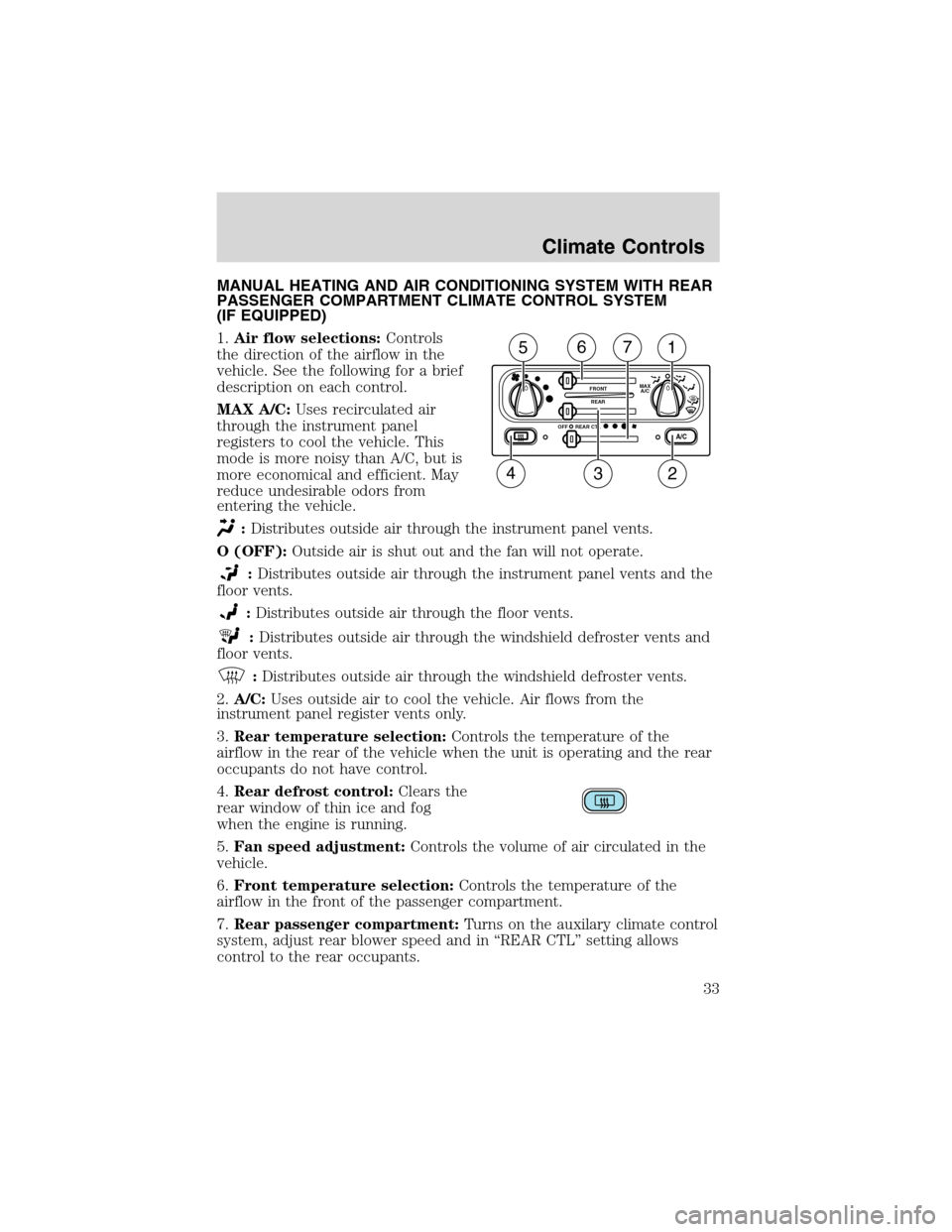
MANUAL HEATING AND AIR CONDITIONING SYSTEM WITH REAR
PASSENGER COMPARTMENT CLIMATE CONTROL SYSTEM
(IF EQUIPPED)
1.Air flow selections:Controls
the direction of the airflow in the
vehicle. See the following for a brief
description on each control.
MAX A/C:Uses recirculated air
through the instrument panel
registers to cool the vehicle. This
mode is more noisy than A/C, but is
more economical and efficient. May
reduce undesirable odors from
entering the vehicle.
:Distributes outside air through the instrument panel vents.
O (OFF):Outside air is shut out and the fan will not operate.
:Distributes outside air through the instrument panel vents and the
floor vents.
:Distributes outside air through the floor vents.
:Distributes outside air through the windshield defroster vents and
floor vents.
:Distributes outside air through the windshield defroster vents.
2.A/C:Uses outside air to cool the vehicle. Air flows from the
instrument panel register vents only.
3.Rear temperature selection:Controls the temperature of the
airflow in the rear of the vehicle when the unit is operating and the rear
occupants do not have control.
4.Rear defrost control:Clears the
rear window of thin ice and fog
when the engine is running.
5.Fan speed adjustment:Controls the volume of air circulated in the
vehicle.
6.Front temperature selection:Controls the temperature of the
airflow in the front of the passenger compartment.
7.Rear passenger compartment:Turns on the auxilary climate control
system, adjust rear blower speed and in“REAR CTL”setting allows
control to the rear occupants.
A/C
FRONT
REAR
OFFMAX
A/C
REAR CTL
234
1567
Climate Controls
33
Page 70 of 240
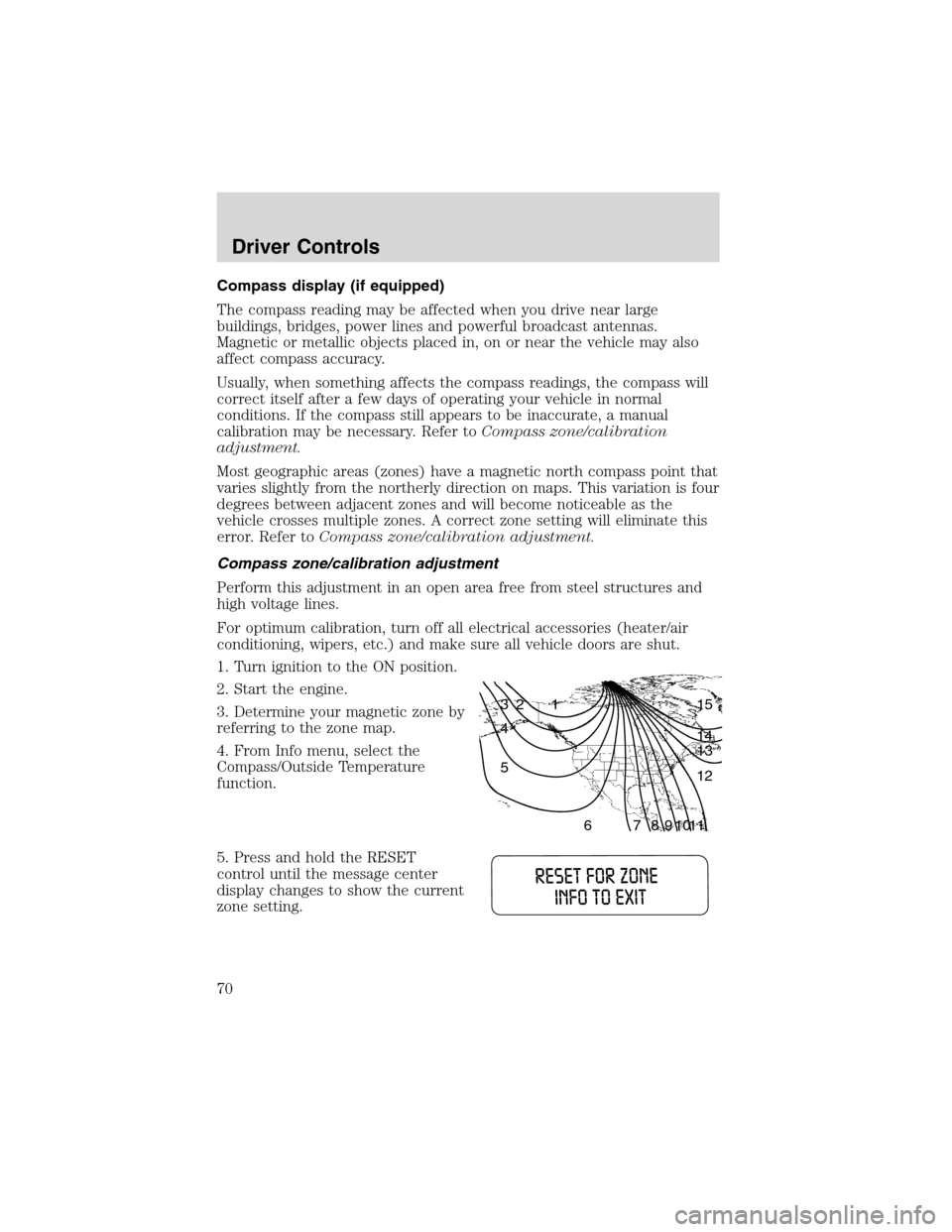
Compass display (if equipped)
The compass reading may be affected when you drive near large
buildings, bridges, power lines and powerful broadcast antennas.
Magnetic or metallic objects placed in, on or near the vehicle may also
affect compass accuracy.
Usually, when something affects the compass readings, the compass will
correct itself after a few days of operating your vehicle in normal
conditions. If the compass still appears to be inaccurate, a manual
calibration may be necessary. Refer toCompass zone/calibration
adjustment.
Most geographic areas (zones) have a magnetic north compass point that
varies slightly from the northerly direction on maps. This variation is four
degrees between adjacent zones and will become noticeable as the
vehicle crosses multiple zones. A correct zone setting will eliminate this
error. Refer toCompass zone/calibration adjustment.
Compass zone/calibration adjustment
Perform this adjustment in an open area free from steel structures and
high voltage lines.
For optimum calibration, turn off all electrical accessories (heater/air
conditioning, wipers, etc.) and make sure all vehicle doors are shut.
1. Turn ignition to the ON position.
2. Start the engine.
3. Determine your magnetic zone by
referring to the zone map.
4. From Info menu, select the
Compass/Outside Temperature
function.
5. Press and hold the RESET
control until the message center
display changes to show the current
zone setting.
1 2 3
4
5
6 7 8 9 101112 13 14 15
Driver Controls
70
Page 134 of 240
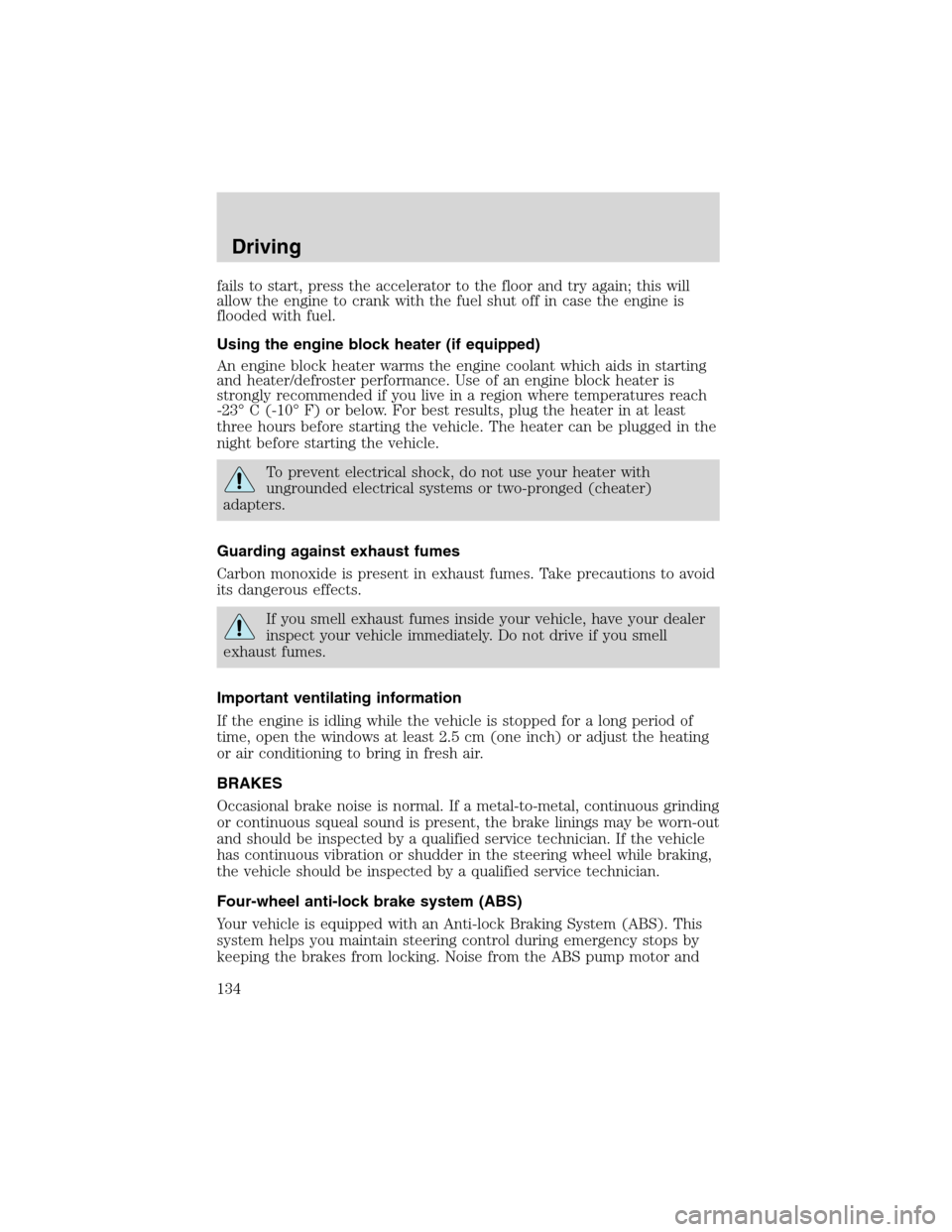
fails to start, press the accelerator to the floor and try again; this will
allow the engine to crank with the fuel shut off in case the engine is
flooded with fuel.
Using the engine block heater (if equipped)
An engine block heater warms the engine coolant which aids in starting
and heater/defroster performance. Use of an engine block heater is
strongly recommended if you live in a region where temperatures reach
-23°C (-10°F) or below. For best results, plug the heater in at least
three hours before starting the vehicle. The heater can be plugged in the
night before starting the vehicle.
To prevent electrical shock, do not use your heater with
ungrounded electrical systems or two-pronged (cheater)
adapters.
Guarding against exhaust fumes
Carbon monoxide is present in exhaust fumes. Take precautions to avoid
its dangerous effects.
If you smell exhaust fumes inside your vehicle, have your dealer
inspect your vehicle immediately. Do not drive if you smell
exhaust fumes.
Important ventilating information
If the engine is idling while the vehicle is stopped for a long period of
time, open the windows at least 2.5 cm (one inch) or adjust the heating
or air conditioning to bring in fresh air.
BRAKES
Occasional brake noise is normal. If a metal-to-metal, continuous grinding
or continuous squeal sound is present, the brake linings may be worn-out
and should be inspected by a qualified service technician. If the vehicle
has continuous vibration or shudder in the steering wheel while braking,
the vehicle should be inspected by a qualified service technician.
Four-wheel anti-lock brake system (ABS)
Your vehicle is equipped with an Anti-lock Braking System (ABS). This
system helps you maintain steering control during emergency stops by
keeping the brakes from locking. Noise from the ABS pump motor and
Driving
134
Page 232 of 240
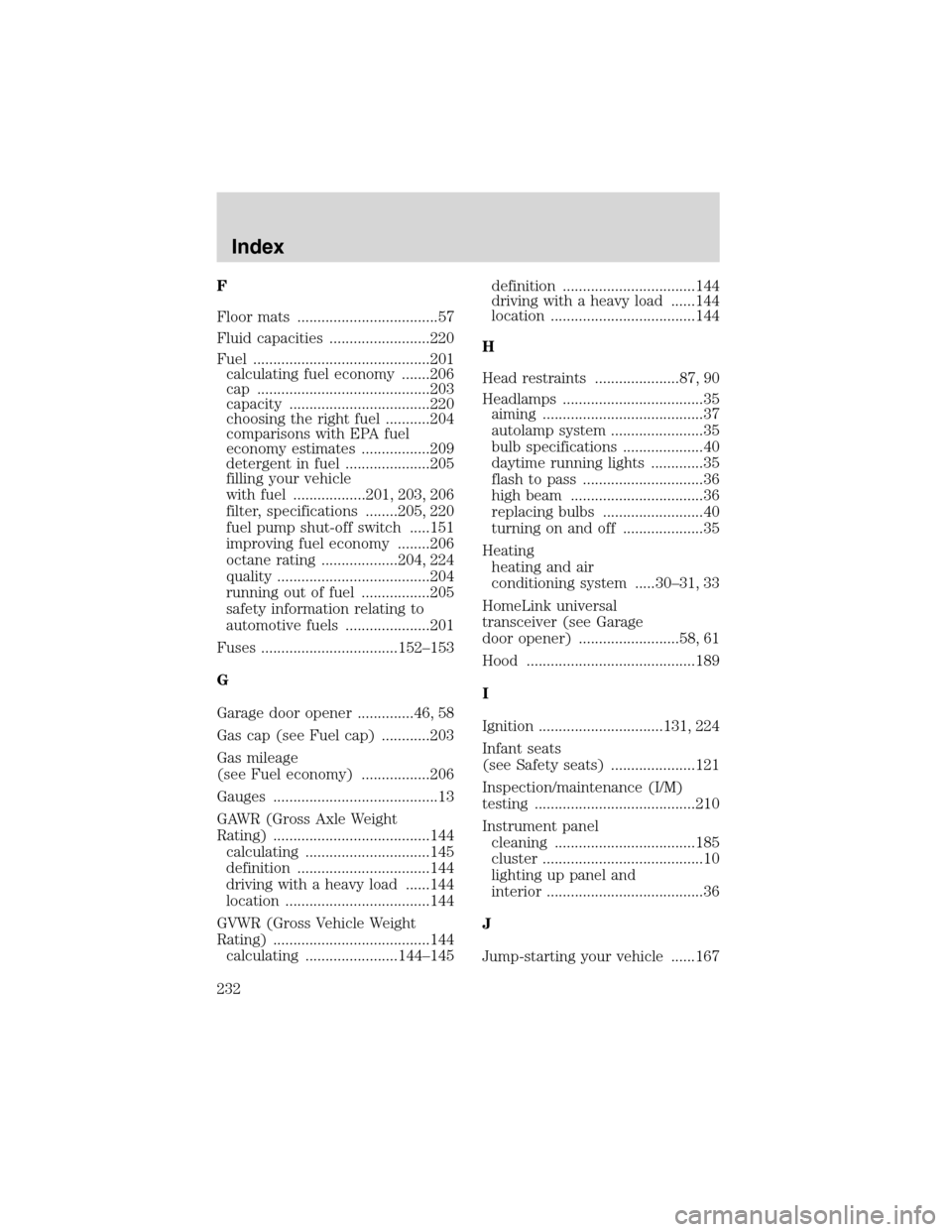
F
Floor mats ...................................57
Fluid capacities .........................220
Fuel ............................................201
calculating fuel economy .......206
cap ...........................................203
capacity ...................................220
choosing the right fuel ...........204
comparisons with EPA fuel
economy estimates .................209
detergent in fuel .....................205
filling your vehicle
with fuel ..................201, 203, 206
filter, specifications ........205, 220
fuel pump shut-off switch .....151
improving fuel economy ........206
octane rating ...................204, 224
quality ......................................204
running out of fuel .................205
safety information relating to
automotive fuels .....................201
Fuses ..................................152–153
G
Garage door opener ..............46, 58
Gas cap (see Fuel cap) ............203
Gas mileage
(see Fuel economy) .................206
Gauges .........................................13
GAWR (Gross Axle Weight
Rating) .......................................144
calculating ...............................145
definition .................................144
driving with a heavy load ......144
location ....................................144
GVWR (Gross Vehicle Weight
Rating) .......................................144
calculating .......................144–145definition .................................144
driving with a heavy load ......144
location ....................................144
H
Head restraints .....................87, 90
Headlamps ...................................35
aiming ........................................37
autolamp system .......................35
bulb specifications ....................40
daytime running lights .............35
flash to pass ..............................36
high beam .................................36
replacing bulbs .........................40
turning on and off ....................35
Heating
heating and air
conditioning system .....30–31, 33
HomeLink universal
transceiver (see Garage
door opener) .........................58, 61
Hood ..........................................189
I
Ignition ...............................131, 224
Infant seats
(see Safety seats) .....................121
Inspection/maintenance (I/M)
testing ........................................210
Instrument panel
cleaning ...................................185
cluster ........................................10
lighting up panel and
interior .......................................36
J
Jump-starting your vehicle ......167
Index
232